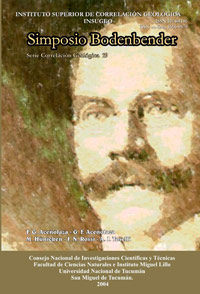Serie Correlación Geológica 19
El Terremoto de 1894: Investigación Histórica
Irene Perez | Graciela E. Tello
Descargar trabajo en formato PDFResumen
EL TERREMOTO DE 1894: INVESTIGACIÓN HISTÓRICA. El terremoto del 27 de octubre de 1894, conocido como “Terremoto Argentino”, es el sismo de mayor magnitud ocurrido en la Argentina y fue descripto por Bodenbender (1894), atendiendo a cómo fue percibido en el Dpto. de Iglesia (San Juan) y en el sur de la Rioja. En ese trabajo, localizó el epicentro al N de los 27° 00’ de Latitud sur. Estudios posteriores ubicaron el epicentro aproximadamente a 30° 50' de Latitud Sur y 68° 40' de Longitud Oeste y le asignaron una magnitud Ms: 8.2. De acuerdo a crónicas de la época, el sismo fue muy fuerte, de carácter ondulatorio y larga duración. Produjo daños de consideración en las ciudades San Juan, La Rioja, en menor grado en Córdoba y Catamarca y se sintió en Buenos Aires (a 1100 kilómetros de la zona epicentral). El número de víctimas fatales fue de alrededor de 100 (cien), ya que el epicentro se ubicó en una región de densidad poblacional muy baja. La exhaustiva revisión de los datos históricos disponibles y el empleo de una adecuada metodología de estudio de sismicidad histórica posibilita precisar la localización del mismo y la intensidad en diversos sitios, lo que se refleja en la confección de un mapa de isosistas.
Abstract
THE 1894 EARTHQUAKE: HISTORICAL INVESTIGATIONS. The earthquake of October 27th 1894, known as the “Argentinean Earthquake”, is the highest magnitude earthquake that took place in Argentina and was described by Bodenbender (1894), on the basis of how it was perceived in Iglesia (San Juan) and in the south of La Rioja. In that paper, he localized the epicenter to the North of the 27° South Latitude. Later studies located the epicenter approximately in the 29° 45’ South Latitude and 69° 00’ West Longitude. Accordingly to the chronicles of that time, the event was very strong, of ondulatory character and it lasted a long time. It caused important damages in the cities of Cordoba and Mendoza and it was felt also in Buenos Aires (1100 kilometers from the area of the epicenter). The number of fatal victims was near 100 (one hundred), possibly because the epicenter was located in a region with very low density of population. The exhaustive review of the available historical information and the use of a proper methodology for the study of the historical seismicity, for the 1894 earthquake, enables to precise its location and intensity in different places, which is reflected in the perform of a map of isosists.






